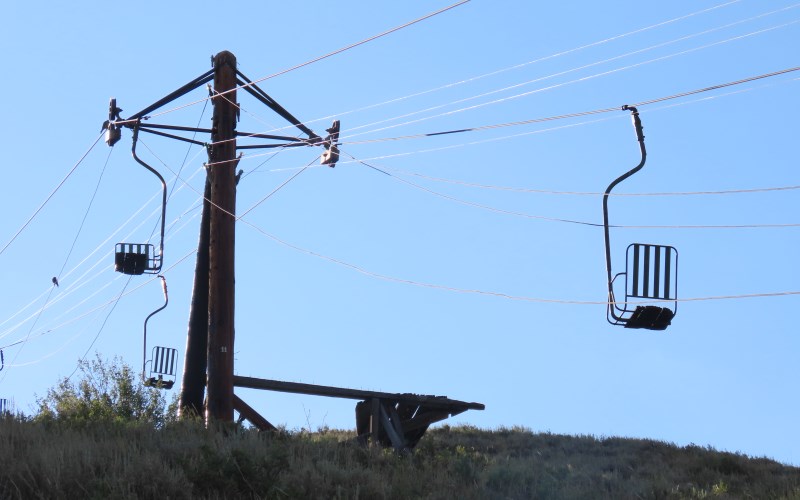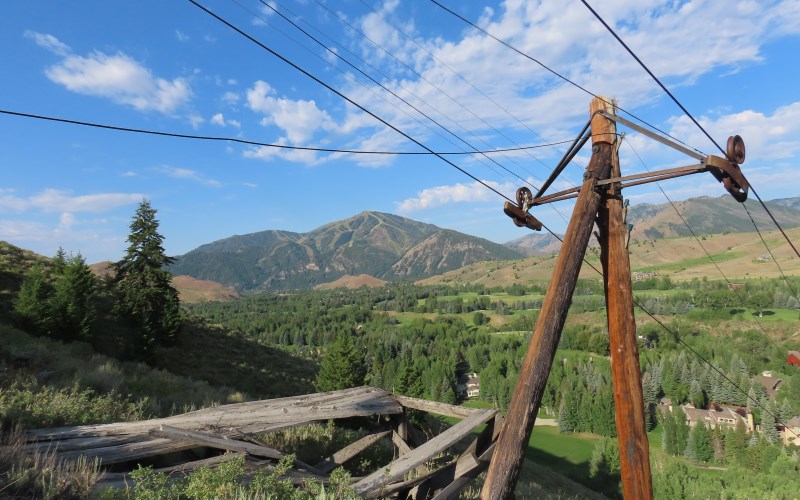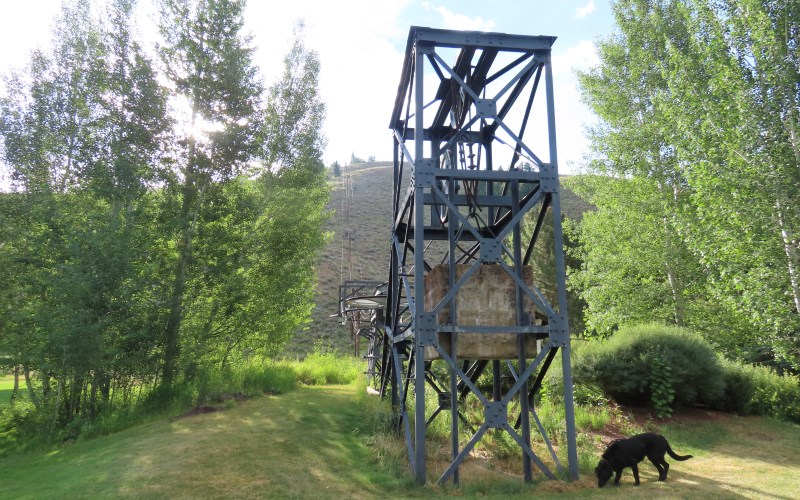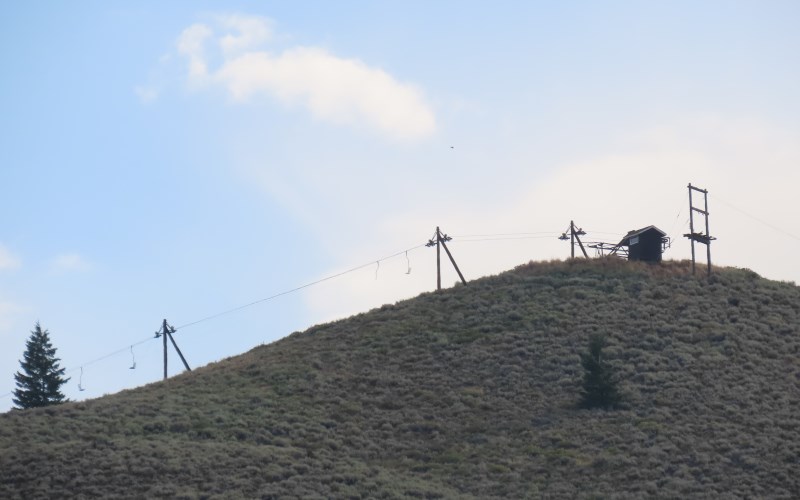|
STORY BY JOHN W. LUNDIN PHOTOS BY KAREN BOSSICK Ski jumping at Sun Valley is a forgotten part of its history, but the sport played an important part in making the resort the country’s center of skiing. A 40-meter ski jump was built on Ruud Mountain in summer 1937, creating Sun Valley’s center for jumping and slalom racing, which became the site of showdowns between many of the world’s best competitors.
|
|

Ruud Mountain’s chairlifts would have a tough time going up against Sun Valley Resort’s high-speed quads.
|
|
|
Called the “St. Moritz of America,” Sun Valley opened in December 1936, built by Union Pacific Railroad to stimulate passenger service decimated by the Great Depression as the pet project of Board Chairman Averell Harriman. The country’s first destination ski resort, it had an ultra-modern lodge offering big city amenities, a ski school with Austrian instructors, and chairlifts invented by Union Pacific engineers. Ski racer Dick Durrance said it was “the most important influence in the development of American skiing...Its concentrated and highly successful glamorization of the sport got people to want to ski in the first place.” Harriman used ski racing to make his new resort the country’s skiing center. Annual Harriman Cup Tournaments were the country’s most prestigious and competitive events, attracting the world’s best skiers. “Just as it is the dream of every tennis player to compete once at Wimbledon, it is every skier’s hope to participate in the famous Harriman Cup Races at Sun Valley,” reported the American Ski Annual in 1943.
|
|

Hikers can still see some of the jumping platforms and other infrastructure on Ruud Mountain.
|
|
|
After the first Harriman Cup tournament in 1937, Harriman realized one thing was missing--a ski jump. Alpine skiing (downhill and slalom racing) was a fledgling sport, and first appeared in the 1936 Olympic Games. For decades, Norwegian immigrants made ski jumping the most popular form of the sport. The best skiers at the time were four-way athletes, competing in downhill, slalom, cross-country and jumping. Newspapers gave extensive coverage of ski jumping events and the best ski jumpers were celebrities, much like professional quarterbacks are today. Harriman asked two famous Norwegian ski jumpers to find a location for a ski jump. One was Sigmund Ruud, a 1928 Olympic Silver Medalist and 1937 National Jumping Champion. The other was Alf Engen, a professional ski jumping champion from 1931 to 1935 and holder of five world professional distance records. They selected a site between Dollar and Proctor mountains, later named Ruud Mountain for Sigmund, with an elevation of 6,600 feet and a 600-foot vertical drop. They designed a 40-meter site intended for jumps up to 131 feet, using the hill’s natural slope, with a profile shaped to exact international specifications.
|
|

Happily, much of the historic infrastructure still stands off Fairway Road.
|
|
|
Major jumping tournaments required a 70 to 90-meter jump, but this was perfect for four-way competitions, although jumpers quickly exceeded the design limit on Ruud Mountain. Alf Engen said Sun Valley’s jump for its size “comes nearer to perfection than any yet developed.” And Dartmouth Coach Walter Prager, in turn, said the Ruud Mountain slalom course was one of the finest and toughest slalom courses he had ever seen. A rudimentary chairlift was installed on Ruud Mountain, using “a small piece of wood--one about 16 inches long and six or eight inches wide” to sit on, according to Warren Miller. It lacked a place for riders’ skis. At a time when skiers had to climb hills before coming down, the lift enabled them to get in far more training runs than ever before. And it delighted jumpers who had been climbing for their skiing all season or jumping off rickety scaffolds on artificial snow. Sun Valley became the country’s only ski area with courses for four-way competitions: Downhill, cross-country, slalom and jumping. This made it eligible for official F.I.S. tournaments, which had never been held outside of Europe.
|
|

This was the lift that early ski jumpers took.
|
|
|
The best jumpers in the world competed on Ruud Mountain, including Alf Engen and his brothers Sverre and Correy; Sigmund and Birger Ruud; Reidar Andersen; Torger Tokle; Art Devlin, all the members of the 1948 U.S. Olympic Jumping team and many others. But jumping on Ruud Mountain dropped off after World War II, as interest in the sport waned. U.S. Olympic teams trained on Ruud Mountain for the 1948 and 1952 Games. And jumping exhibitions continued, featuring top Norwegian exchange students, but not as part of the Harriman Cup. Ruud Mountain’s last formal jumping event was the 1956 American Legion Junior Three-Way Championships. Slalom races were held there through 1961, often with side-by-side courses for men and women. The 1961 Harriman Cup slalom race was the last, won by Billy Kidd. In 1965, the movie “Ski Party” was filmed at Sun Valley--a light-weight musical comedy knock-off of beach party movies. It starred Frankie Avalon and Dwayne Hickman, with an appearance by Annette Funicello, and musical appearances by Leslie Gore and James Brown. The movie has scenes filmed on Ruud Mountain. Among them, conventional ski jumps; Frankie Avalon jumping in an inflated clown suit, soaring off like a helium balloon; and a toboggan flying off the jump.
This was the last formal use of the ski jump. EDITOR’S NOTE: John W. Lundin is a lawyer, historian and author who has published four award-winning books, including “Skiing Sun Valley: A History from Union Pacific to the Holdings,” and “Sun Valley, Ketchum and The Wood River Valley.” He has written numerous magazine articles, is a frequent lecturer in Seattle and Sun Valley, has made a series of TV history shows with Eye on Sun Valley and assisted with making “Tracks in Time: History of Idaho Railroads” for Idaho Public TV.
|